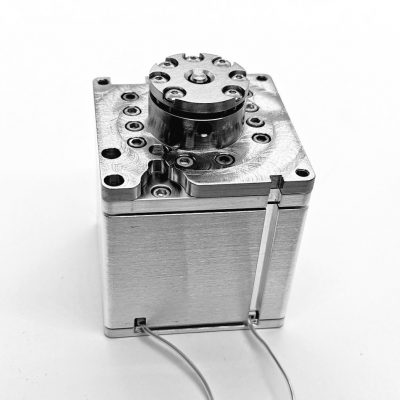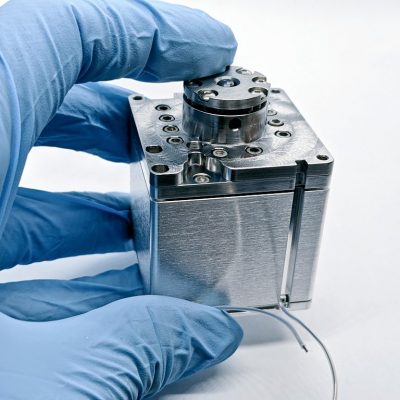OVERVIEW
The AIS-AHT1-PQ is the latest and most advanced thruster yet at AIS, and the newest thruster of the ADAMANT Series development. With the unique propellant selection of Adamantane, a solid hydrocarbon diamandoid that exhibits direct sublimation at low temperatures, pressurized feed is eliminated from the Hall thruster design.
The ADAMANT Series aims to tackle scaling for conventional Hall thruster technology down to the smallest levels of nanosats by focusing on a highly unconventional fuel source to eliminate complex valving, metering, and pressurized tanks. Unlike Iodine, which is currently one of the top candidates for alternative fuels for EP, Adamantane does not exhibit serious material corrosion issues, and is not nearly as toxic to handle, while having a larger ionization cross-section (easier to ionize).
What you see is literally everything – fuel tank, valve, heater, Hall thruster, and electronics, all integrated in a total volume of only 42x42x56mm. The AHT1-PQ holds 18g of Adamantane fuel, and at 0.1U total volume, is the smallest full Hall thruster system ever designed. The AHT1-PQ was designed to radically push the limits of Hall thruster scaling, and to provide a system compact and low power enough with unpressurized fuel to be integrated with Pocketqubes, making it the first and only PQ compatible Hall thruster design on the market.
With its solid metal aluminum tank with a vacuum grade propulsion valve directly integrated with the tank body, in addition to integrated heater, and direct vertical stacking to the Hall thruster head, the full AHT1-PQ package fully eliminates feedlines and complexity, allowing for a highly compact and modular design.
In addition, the AHT1-PQ leverages neutralizer-less operation, which takes advantage of the high voltage/low-current mode of operation and properties of anode layer ion sources being self igniting as well as the ability to generate self-neutralizing beams, which is often used in the industrial beam processing, surface sciences, and semiconductor manufacturing fields with industrial anode layer ion sources.
With the AHT1-PQ, Applied Ion Systems aim to defy convention and redefine scaling and accessibility of Hall thrusters to a level never before realized or seen in the EP field prior, providing the lowest cost, most compact, and most accessible Hall thruster to hit the nanosatellite market.
TECHNICAL SPECIFICATIONS
- Price: $6500
- Thruster Type: Pico Hall Thruster
- Fuel: Adamantane
- Nominal Power: <10W
- Size: 42mm x 42mm x 56mm (0.1U)
- Dry Mass: TBD
- Fuel Capacity: 18 grams
- Total Impulse: TBD
- Thrust: TBD (est. 20-50uN)
- ISP: TBD (est. <500s)
- Status: ACTIVE
DESIGN FILES
COMING SOON!!!
ENGINEERING TEST REPORTS
COMING SOON!!!
GALLERY
AIS-AHT1-PQ Pico Anode Layer Hall Thruster Gallery
VACUUM TEST PLATFORM
Micro Propulsion Testing Chamber
UPDATE LOG
- 07/16/2021 – First official reveal of the AHT1-PQ conceptual CAD model renders.
- 08/04/2021 – First official reveal of the AHT1-PQ discharge and fuel valve control PCB design.
- 08/14/2021 – V1 PCBs for discharge and fuel valve control arrived from OSH Park.
- 08/20/2021 – Lee Co. IEP Series valve passes first testing, and V1 PCBs pass testing for valve circuit control.
- 08/21/2021 – HV discharge circuit passes high vacuum breakdown testing.
- 08/25/2021 – Newly fabricated tank and Hall thruster arrive from Xometry. Live unboxing of the new parts is done.
- 08/26/2021 – First preliminary assembly of the AHT1-PQ is complete.
- 08/27/2021 – Preliminary test assembly of the spare tank and valveless feed with the Hall thruster head is complete.
- 08/28/2021 – Final assembly and wiring of the full system is complete for testing. First ignition test is run. Ignition is unsuccessful.
- 08/31/2021 – Thruster is disassembled and inspected after the first ignition test. Multiple issues found in the initial design, requiring modifications.
- 09/01/2021 – New modification design is complete and sent off the Xometry for manufacture.
- 09/11/2021 – Second ignition test of the AHT1-PQ was conducted with new 3D printed insulator insert and modified ring anode. Ignition was unsuccessful.
- 09/18/2021 – Third ignition test of the AHT1-PQ was conducted with new 3D printed insulator insert from the prior test and copper crown anode. Ignition was unsuccessful.
- 09/23/2021 – Fourth ignition test of the AHT1-PQ was conducted with new 3D printed insulator insert from the prior test and original modified ring anode at a higher discharge power of 9W. Ignition was unsuccessful.
- 09/26/2021 – Fifth ignition test of the AHT1-PQ was conducted. The same configuration as the prior test was used, except with reduced magnetic field strength. Some improvement, but ignition was unsuccessful.
- 10/01/2021 – Sixth ignition test of the AHT1-PQ was conducted. The same configuration as the prior test was used, except the pole piece cap was drilled out to a larger bore diameter. No plasma observed, and ignition was unsuccessful.
- 10/23/2021 – New modified V2 design was revealed, with redesigned insert, anode, and pole pieces. Parts summitted to Xometry for fabrication.
- 10/29/2021 – New V2 3D printed insert arrived from Xometry.


